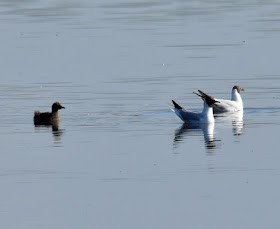 |
| Reed Warbler building second nest (c) JR |
“Summertime and the living is easy……” as George Gershwin
wrote…..and that is true right now down on the moor. Birds are taking advantage
of the massive numbers of insects that are thriving on the lush vegetation. We
are seeing small birds foraging everywhere and dashing back to chicks with
beaks stuffed with insect food.
 |
| Young Sedge Warbler (c) Bark |
Out on Greenaways up to four common Cranes have been feeding
in the long grasses. The grasses have subtly changed colour shifting from the
rich greens of two or three weeks ago to gold, warm browns and ochre as they
set seed. Walking through the grass it is impossible not to notice the huge
numbers of grasshoppers that leap and scatter at your passage. It is likely
that it is this abundant food source, that the Common Cranes are feeding on as
they moult into their new flight feathers. Careful and patient scanning is
needed to spot the moment when one or other long neck appears above the grass,
like a periscope on a submarine. As well as “our” Cranes there appears to be
another pair that are able to fly and are visiting, all four were seen close
together last week.
 |
| Taking advantage of the seed put down for their rarer cousins (c) Derek Latham |
Bullfinches appear to have had a successful breeding season
so far, this year if the number of family parties that are about is anything to
go on. They are very noticeable in the carpark field, along the bridleway and
on the path beside the hide. Chaffinches are very evident too, taking advantage
of the seed that is being put down specially for the Turtle Doves. The cattle
have commandeered this area by the stockade and it is difficult to get near it
to scatter the feed. There are currently several large flocks of juvenile
Starlings around on the moor, last week we had a flock of at least three
hundred feeding in the long grass in Long Meadow. There is one such group that
is staying close to the cattle and it is easy to see that they are all brown
juvenile birds, I assume that the adults are all off raising further broods.
 |
| Cattle and Starlings (c) Derek Latham |
The first trickle of returning or non-breeding waders have
appeared. There were two Little Ringed Plovers on the Greenaways scrape on
Saturday morning and there are reports of Green Sandpipers being both seen and
heard last week.
 |
| Little Ringed Plovers(c) Derek Latham |
At the first screen, along with the regular eclipse ducks,
were two Black headed gull chicks that can only have come from a nest in the
reedbed one of them swimming about in the middle of the lagoon accompanied by
anxious and very noisy parents. The other was pottering about on the emerging
mud patch on the left-hand side of the channel and accompanied by attendant
parents. There were also three juvenile Little Egrets and two adult birds in
the same area. The juveniles could all fly well enough and so are not likely to
have fledged on the moor, but their landing and perching skills still need a
lot of practice.
 |
| Egrets et al (c) JR Black Headed Gulls and chick (c) Bark |
We were pleased to see two newly fledged Marsh Harriers
making their first flights at the weekend. Like the Egrets they can fly
reasonably well but getting back down is a skill that is still to be mastered.
Their landings in the low willows and bushes being no more than very wobbly flappy
crashes. It is great to be able to report that the Marsh Harriers have bred
successfully for the third successive year. Bitterns have been seen again
intermittently and observations made last week suggest that there are feeding
flights being made but as yet we have seen no newly fledged birds.
At the second screen the Common Terns chicks are growing
apace. They are demonstrating different stages of development at least one bird
looks very much as though it will be fledged in about a week, others are still
at the portly downy stage. They are being brought a steady stream of fish, some
of them large, the returning adults often coming in from the direction of the
River Ray. While watching the Terns we were alerted to the presence of a raptor by the behaviour first of a group of starlings on the flood and then
the Terns themselves, it was the Hen Harrier and we saw it briefly as it passed
over the Barn Field before disappearing behind the hedge. Nonetheless it was
good to know that it is still here.
 |
| Fritillary, Comma and Peacock all between the screens (c) Bark |
Back on the insect front we were very pleased to find a Silver
Washed Fritillary quite close to the second screen nectaring on thistles, some
way from woodland but near to an oak hedgerow. The first pristine Peacocks were
on the wing. Last week a swarm of bees was seen flying over the second screen
before settling in the hedgerow behind it. They had moved on by Saturday perhaps
occupying one of the hollow, pollarded old willows that line the Ray, but once
more showing that there is always something new to see and find on Otmoor.
 |
| The Swarm (c) Stoneshank |




This comment has been removed by the author.
ReplyDelete"Every animal or bird has its own feeding way. These pictures illustrate it in the best given way. Can't believe all of it is natural and so true
ReplyDelete"